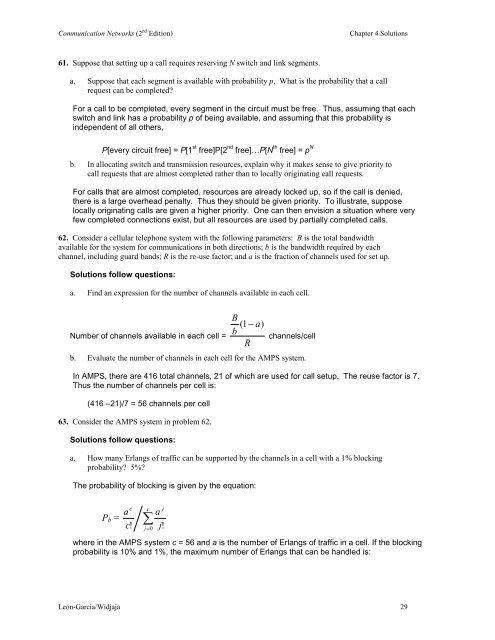Solutions to Chapter 4 - Communication Networks
Solutions to Chapter 4 - Communication Networks
Solutions to Chapter 4 - Communication Networks
You also want an ePaper? Increase the reach of your titles
YUMPU automatically turns print PDFs into web optimized ePapers that Google loves.
<strong>Communication</strong> <strong>Networks</strong> (2 nd Edition)<br />
<strong>Chapter</strong> 4 <strong>Solutions</strong><br />
61. Suppose that setting up a call requires reserving N switch and link segments.<br />
a. Suppose that each segment is available with probability p. What is the probability that a call<br />
request can be completed<br />
For a call <strong>to</strong> be completed, every segment in the circuit must be free. Thus, assuming that each<br />
switch and link has a probability p of being available, and assuming that this probability is<br />
independent of all others,<br />
P[every circuit free] = P[1 st free]P[2 nd free]…P[N th free] = p N<br />
b. In allocating switch and transmission resources, explain why it makes sense <strong>to</strong> give priority <strong>to</strong><br />
call requests that are almost completed rather than <strong>to</strong> locally originating call requests.<br />
For calls that are almost completed, resources are already locked up, so if the call is denied,<br />
there is a large overhead penalty. Thus they should be given priority. To illustrate, suppose<br />
locally originating calls are given a higher priority. One can then envision a situation where very<br />
few completed connections exist, but all resources are used by partially completed calls.<br />
62. Consider a cellular telephone system with the following parameters: B is the <strong>to</strong>tal bandwidth<br />
available for the system for communications in both directions; b is the bandwidth required by each<br />
channel, including guard bands; R is the re-use fac<strong>to</strong>r; and a is the fraction of channels used for set up.<br />
<strong>Solutions</strong> follow questions:<br />
a. Find an expression for the number of channels available in each cell.<br />
Number of channels available in each cell =<br />
B<br />
( 1−<br />
a)<br />
b<br />
R<br />
channels/cell<br />
b. Evaluate the number of channels in each cell for the AMPS system.<br />
In AMPS, there are 416 <strong>to</strong>tal channels, 21 of which are used for call setup. The reuse fac<strong>to</strong>r is 7.<br />
Thus the number of channels per cell is:<br />
(416 –21)/7 = 56 channels per cell<br />
63. Consider the AMPS system in problem 62.<br />
<strong>Solutions</strong> follow questions:<br />
a. How many Erlangs of traffic can be supported by the channels in a cell with a 1% blocking<br />
probability 5%<br />
The probability of blocking is given by the equation:<br />
P b =<br />
c<br />
a<br />
c!<br />
c<br />
<br />
a<br />
j<br />
j<br />
j=<br />
0 !<br />
where in the AMPS system c = 56 and a is the number of Erlangs of traffic in a cell. If the blocking<br />
probability is 10% and 1%, the maximum number of Erlangs that can be handled is:<br />
Leon-Garcia/Widjaja 29







